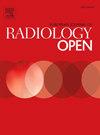Post-deployment performance of a deep learning algorithm for normal and abnormal chest X-ray classification: A study at visa screening centers in the United Arab Emirates
IF 2.9
Q3 RADIOLOGY, NUCLEAR MEDICINE & MEDICAL IMAGING
引用次数: 0
Abstract
Background
Chest radiographs (CXRs) are widely used to screen for infectious diseases like tuberculosis and COVID-19 among migrants. At such high-volume settings, manual CXR reporting is challenging and integrating artificial intelligence (AI) algorithms into the workflow help to rule out normal findings in minutes, allowing radiologists to focus on abnormal cases.
Methods
In this post-deployment study, all the CXRs acquired during the visa screening process across 33 centers in United Arab Emirates from January 2021 to June 2022 (18 months) were included. The qXR v2.1 chest X-ray interpretation software was used to classify the scans into normal and abnormal, and its agreement against radiologist was evaluated. Additionally, a digital survey was conducted among 20 healthcare professionals with prior AI experience to understand real-world implementation challenges and impact.
Results
The analysis of 1309,443 CXRs from 1309,431 patients (median age: 35 years; IQR [29–42]; 1030,071 males [78.7 %]) in this study revealed a Negative Predictive Value (NPV) of 99.92 % (95 % CI: 99.92, 99.93), Positive Predictive Value (PPV) of 5.06 % (95 % CI: 4.99, 5.13) and overall percent agreement of the AI with radiologists of 72.90 % (95 % CI: 72.82, 72.98). In the survey, majority (88.2 %) of the radiologists agreed to turnaround time reduction after AI integration, while 82 % suggested that the AI improved their diagnostic accuracy.
Discussion
In contrast with the existing studies, this research uses a substantially large data. A high NPV and satisfactory agreement with human readers indicate that AI can reliably identify normal CXRs, making it suitable for routine applications.
用于正常和异常胸部 X 光片分类的深度学习算法的部署后性能:阿拉伯联合酋长国签证筛查中心的一项研究
背景胸片(CXR)被广泛用于筛查传染性疾病,如肺结核和移民中的 COVID-19。在这种高容量的环境中,人工 CXR 报告具有挑战性,而将人工智能(AI)算法整合到工作流程中有助于在几分钟内排除正常结果,使放射科医生能够专注于异常病例。方法在这项部署后研究中,纳入了 2021 年 1 月至 2022 年 6 月(18 个月)期间阿拉伯联合酋长国 33 个中心在签证筛查过程中获得的所有 CXR。研究人员使用 qXR v2.1 胸部 X 光解读软件将扫描结果分为正常和异常两类,并评估了该软件与放射科医生的一致性。此外,还对 20 名具有人工智能经验的医疗保健专业人员进行了数字调查,以了解现实世界中实施人工智能所面临的挑战和产生的影响。7 %])的阴性预测值 (NPV) 为 99.92 %(95 % CI:99.92,99.93),阳性预测值 (PPV) 为 5.06 %(95 % CI:4.99,5.13),人工智能与放射科医生的总体一致率为 72.90 %(95 % CI:72.82,72.98)。在调查中,大多数放射科医生(88.2%)同意在集成人工智能后缩短周转时间,82%的放射科医生认为人工智能提高了他们的诊断准确性。高 NPV 和与人类读者的满意度表明,人工智能能可靠地识别正常的 CXR,因此适合常规应用。
本文章由计算机程序翻译,如有差异,请以英文原文为准。
求助全文
约1分钟内获得全文
求助全文
来源期刊

European Journal of Radiology Open
Medicine-Radiology, Nuclear Medicine and Imaging
CiteScore
4.10
自引率
5.00%
发文量
55
审稿时长
51 days
 求助内容:
求助内容: 应助结果提醒方式:
应助结果提醒方式:


